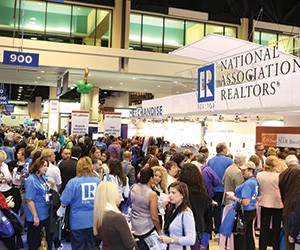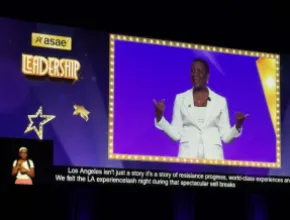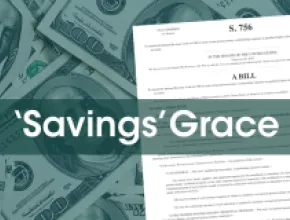Association meeting planners face many of the same tests as other event coordinators in a rebounding economy, with one major additional challenge: They must attract members who aren’t necessarily required to attend the group’s annual conference and other functions.
Because of this key difference and the challenging financial landscape, it’s now more important than ever to showcase the value an upcoming meeting can provide attendees, well before it even takes place.
Thankfully, association planners have some useful marketing tools on their side—in the form of new database technology and social media. These generally cost-effective tools, combined with more traditional methods, can go a long way in expressing the importance of attending a face-to-face event.
Here is a breakdown of some key attendance-driving factors, with input from association professionals Allison Fitch-Markham, marketing director for the conventions division of the National Association of Realtors (NAR), and Mary Mackay, marketing director for the American Library Association (ALA).
Marketing
The successful marketing of any association meeting comes down to one key factor; explaining the benefit to the attendee of spending the time and money to attend an event–while leaving other important work-related duties behind.
“One big challenge is just stressing the value of face-to-face meetings, particularly in an online-driven generation,” Fitch-Markham says. “We often use data to back up the value of our events.”
During the past five years since the NAR started tracking data, it discovered regular event attendees reported making double the amount of income from real estate when compared to non-attending members of the association. Fitch-Markham also notes that her group actively mines and searches for other information on its members to help with promotion efforts.
“We’re fortunate in that we’re a membership association, so we have a lot of data on our members,” she says. “That sounds kind of creepy, but just by using their membership I.D. number we can mine the database to look for patterns to use in our marketing promotions.”
Sure, data mining sounds great in theory, but what if your group doesn’t have all of the resources of a huge organization like the NAR?
The American Library Association (ALA) is familiar with budget cuts among its members, as many libraries are government-funded and often compete with other digital providers of information for business.
“Budgets are obviously an issue, and many of our members either subsidize or pay for attendance out of their own pockets,” Mary Mackay says. “We are working to help show members why they’ll be more useful to their institution after attending a conference and offer materials on our website to help them put together a strong case for it. Those materials include a budget spreadsheet and feedback from attendees of previous conferences.”PageBreak
Site Selection/Location
The long-held mantra of a real estate agent is “location, location, location,” and while it’s a bit cliched at this point, it holds true for an association planner as well.
Fitch-Markham notes that while the annual REALTORS Conference & Expo is limited in where it can be held due to its larger size (attendance has stayed within a range of 16,000 to 30,000 attendees on average since 1998), location is still a very important factor in whether someone decides to attend the event.
“People are ultimately looking for a great experience and certainly a city is part of that experience, but moving around also helps,” she says. “For example, we did San Diego a few years ago, and we noticed a greater influx of first-time attendees; people who maybe didn’t have the financial means to travel but now the conference is in their area and they’re excited to be able to come down to see the show.”
This year’s REALTORS Conference & Expo will be held Nov. 8-11 at the Moscone Center in San Francisco, and Fitch-Markham says the group has future meeting sites planned through 2019. However, official marketing promotion for the annual event starts about 14 months out.
Mackay, who was busily preparing for the ALA Annual Conference & Exhibition at McCormick Place in Chicago at press time (the event took place from June 27 to July 2), says that while she thinks location is important, the ALA chooses to focus its efforts on spreading the benefits of the conference itself.
“It obviously helps some attendees when we’re in an affordable city, but they also enjoy interesting cities—with good food!—and many make a point of combining attending the conference with staying extra time to enjoy the location,” Mackay says.
Social Media
Social media is one of the most cost-effective ways for an association to build its brand and interact with members. Both the NAR and ALA have used social media in varying ways to promote upcoming events, as well as follow-up with attendees afterwards.
“Social media is integrated into everything we do,” Mackay says. “We’ve learned that we need to reach people through the widest possible variety of media with a range of messages, from e-mail marketing to social media, especially Twitter, Facebook, Pinterest and Tumblr.”
In addition to creating a specialized section of its site dedicated to informing members of the 2013 ALA Annual Conference & Exhibition, the group also prominently links to its social media pages, including a Tumblr page that collects music, videos, artwork and Internet memes to promote the upcoming event and its hashtag, #ala2013.
Fitch-Markham says social media plays a huge role in the NAR’s promotion of its REALTORS Conference & Expo and chooses to focus its efforts mostly on Facebook, LinkedIn, Twitter and YouTube, and yes, they do have a hashtag (#narannual).
“We replicate all of our communications through social media, so even if we have a print brochure, we’ll actually turn that into an electronic publication you can flip through online and we’ll push that out to our social networks,” Fitch-Markham says. “We generally don’t mail our print materials to 100 percent of our membership, that’s one million Realtors and that’s a big project, so we’re a bit more selective. This ensures the brochure is actually available to anyone who would like to look at it.”
NAR also started an even larger award-winning social project called Conference Live in 2010, which Fitch-Markham says is meant to be a virtual window into the conference experience and was ranked as being one of the “Best Social Media Initiatives” by PCMA’s Convene magazine in 2012.
“We recruit featured attendees from a variety of different real estate backgrounds who are comfortable documenting their experience online, whether it’s through posts or photos or their own videos,” she says. “Those featured attendees generally have their own large social networks so we leverage them to generate great content and also to help us with word-of-mouth marketing about the event.”PageBreak
Content/Speakers
Meetings industry veteran Corbin Ball, CSP, CMP, is no stranger to working the speaking circuit at association events, and while he thinks virtual meetings and webinars are all good ways of disseminating less-complex information, he says nothing beats a face-to-face meeting for relationship-building, brainstorming and networking.
“Education and networking are the two major reasons why people come to association events, and if you can provide that in a richer way, that’s a good thing,” Ball says. “When you boil meetings down to the most essential element, we are bringing people together.”
Because of the industry it represents, the NAR is able to lock down some high-profile speakers, such as former Secretary of State Hillary Rodham Clinton, for the upcoming 2013 REALTORS Conference & Expo. Landing a speaker with that much fame might not be possible for many smaller associations, but there are still plenty of opportunities to provide engaging educational content.
“Every year our education director is staying on top of the trends and the issues, and she works very, very, closely with each of our internal departments as well as a committee of our members who give us really valuable input on some of the challenges going on in the industry,” Fitch-Markham says. “She then collects all of that input and works to develop a really broad education program that’s also current to the challenges Realtors are facing in their business.”
The ALA also has some famous speakers lined up for 2013, including authors Alice Walker, Khaled Hosseini and Steven D. Levitt, but Mackay agrees that great educational sessions are paramount to any successful association event.
“The basics haven’t changed; to keep attendees engaged we need to be sure that the content of sessions is relevant, current, engaging, and will genuinely offer attendees innovative ideas and solutions to challenges they face in their work,” Mackay says. “We go for a good mixture of speakers, including thought-leaders and experts from both within and outside the library field.”







